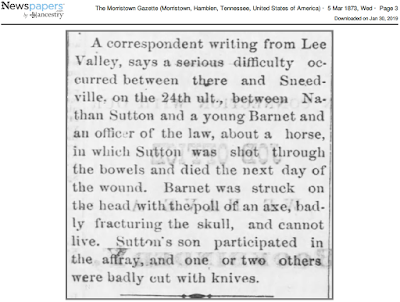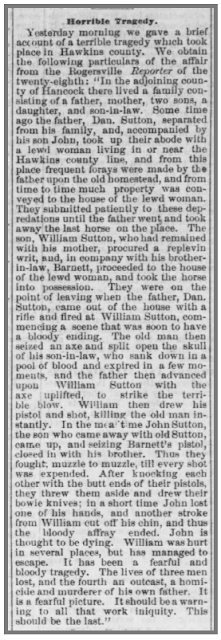Now that I am retired, I have the time to go to the library when I hope to solve a mystery in the family tree. In fact, up until one year ago, I could easily combine my online search and have microfilm sent to the local Family History Library. Familysearch.org no longer offers this option since the bulk of their collection has been digitized. I was happy to see several rolls in their collection for Hancock County, TN. This is a burned county so not many records can be obtained or so I thought. I ordered a roll that included the 1870’s as I hoped to find probate records for my 2x’s great-grandfather, James Sutton. I was ecstatic when I received the notice that the microfilm had arrived so off I went to the library.
Microfilm records can be quite a challenge since they don’t allow you to easily search for a name. Luckily, this roll did have folders for each case that had been filmed. There were many names I recognized from census records but I was not finding James. What did I find on this roll? There were two files that I would save -- the probate paperwork for Peter Wolfe’s estate and the petition for the divorce of Nathan Sutton and Nancy Virginia Sutton. Suttons! I had previously received information, from another researcher, about the divorce and was also informed that their home and property were actually acquired through Nancy’s legacy. Reading this folder appeared to validate the information I received. Nathan and Nancy are my third great-uncle and aunt and there seems to be much tragedy in their line.
Research of this branch of Suttons began years ago when my father was contacted by a group of Sutton researchers. One gentleman, Charlie Clint Sutton, was hoping to write a book about his Sutton ancestors and include all the lines. Charlie lived in Kansas and engaged the help of another researcher named Jim Lawson who most likely lived near Sneedville. Charlie's parents were Bishop Sutton and Mary Jane Jones. Bishop's father was George Washington Sutton who married Rachel Emily Ball. George was the son of Thomas Sutton and Hannah Lawson's youngest son, Thomas who married Matilda Brown. This project turned out to be a huge undertaking so he revised his publication plan. It provided a summary of some research found on Thomas Sr. (a will and his land records), the story of the murder of Henley Sutton, and the story of supposed Native American ancestry. The information proved to be helpful but left my father wanting more. I think we can all relate to that feeling. He made a plan and traveled to Sneedville where he was given a few people to contact but eventually lost interest in genealogy.
Years later I picked up the paper trail and began to find online newspaper articles that were not so kind to the Suttons of Hancock County. Here is an example of one of the articles that I found:
Who was the young Barnet and did a son really get in on the fracas? Other articles gave incorrect first names (perhaps to protect the innocent - sarcasm) but mentioned that a son-in-law was involved. I began to review my tree as I have a Barnard line that is often referred to as Barnetts and wondered if he was related. This is why my Ancestry tree is so big. I am constantly researching a collateral line in hopes of busting through a brick wall. I discovered that Nathan’s daughter, Aisley or Elsie, married Henderson “Hence” Barnard. Digging a little further I discovered that Aisley was widowed on the 1880 census. How sad! Why would Nathan do this? Also, if I have traced Hence's line correctly then he is the grandson of Jonathan Barnard and Biddy Barnet. Many of us descend from this line. His parents were Samuel Barnard and Elizabeth Sanders. He would be my first cousin 4x's removed.
Back to my discovery. Nancy Virginia Sutton (nee Dodson) filed the petition for divorce on April 15, 1872. They had married on November 12, 1840 in Claiborne County, TN so this union had lasted 32 years. Apparently two years prior to this date, Nathan had abandoned his wife and children, two were still minors, and he was accused of “living in adultery with a mean lewd woman.” Wow, this sounds very much like something you would see in today’s divorce proceedings. In reading through the divorce there is the discussion of separation of assets and property. Nathan was apparently in debt and deals were made with individuals such as F. M. Fulkerson and Henley Sutton, his son, to pay off notes. There is mention of a gun and horse that were taken from the home and Nathan later makes a statement that these items were sold to Mack Berry. Now this particular reference could have led to the killing in 1873. The following newspaper article mentions a writ of replevin. Apparently, that would have been issued to recover property wrongly taken. This article was obtained through Newspapers.com and published in the Memphis Daily Appeal on March 5, 1873.
My takeaway from this article and the divorce paperwork is that horse was still an issue and Hence and Henley were trying to recover it. I know Henley occasionally worked for the sheriff’s office from newspaper articles that were published about him. Was he accompanying Hence on behalf of the sheriff’s office or as a family member? Henley did end up owning the house that, I assume, was considered his mother's legacy. Ironically, in the 1889 newspaper coverage of his own murder, he would be referred to as a “desperate man who shot his own father.”
How did Nathan get through the months of legal action just to commit the senseless killing of a son-in-law who was a father of four? Did he also attack Henley who in turn defended himself against the assault by shooting him? Were charges filed against Henley? We will never know unless one of us discovers more court documents regarding this assault. That makes me wonder…


